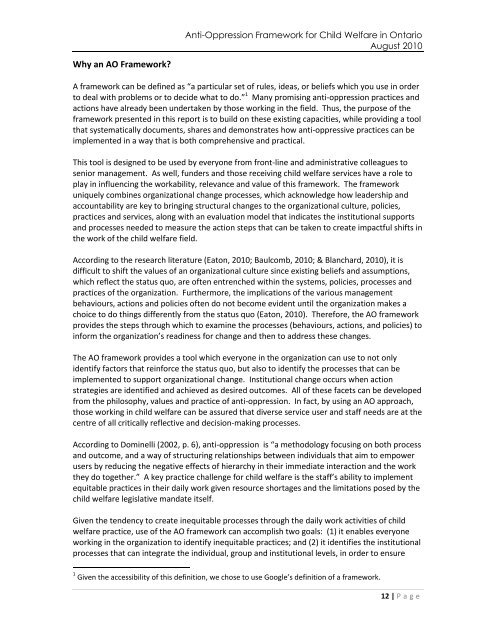An Anti-Oppression Framework for Child Welfare in Ontario
An Anti-Oppression Framework for Child Welfare in Ontario
An Anti-Oppression Framework for Child Welfare in Ontario
You also want an ePaper? Increase the reach of your titles
YUMPU automatically turns print PDFs into web optimized ePapers that Google loves.
<strong>An</strong>ti-<strong>Oppression</strong> <strong>Framework</strong> <strong>for</strong> <strong>Child</strong> <strong>Welfare</strong> <strong>in</strong> <strong>Ontario</strong>August 2010Why an AO <strong>Framework</strong>?A framework can be def<strong>in</strong>ed as “a particular set of rules, ideas, or beliefs which you use <strong>in</strong> orderto deal with problems or to decide what to do.” 1 Many promis<strong>in</strong>g anti-oppression practices andactions have already been undertaken by those work<strong>in</strong>g <strong>in</strong> the field. Thus, the purpose of theframework presented <strong>in</strong> this report is to build on these exist<strong>in</strong>g capacities, while provid<strong>in</strong>g a toolthat systematically documents, shares and demonstrates how anti-oppressive practices can beimplemented <strong>in</strong> a way that is both comprehensive and practical.This tool is designed to be used by everyone from front-l<strong>in</strong>e and adm<strong>in</strong>istrative colleagues tosenior management. As well, funders and those receiv<strong>in</strong>g child welfare services have a role toplay <strong>in</strong> <strong>in</strong>fluenc<strong>in</strong>g the workability, relevance and value of this framework. The frameworkuniquely comb<strong>in</strong>es organizational change processes, which acknowledge how leadership andaccountability are key to br<strong>in</strong>g<strong>in</strong>g structural changes to the organizational culture, policies,practices and services, along with an evaluation model that <strong>in</strong>dicates the <strong>in</strong>stitutional supportsand processes needed to measure the action steps that can be taken to create impactful shifts <strong>in</strong>the work of the child welfare field.Accord<strong>in</strong>g to the research literature (Eaton, 2010; Baulcomb, 2010; & Blanchard, 2010), it isdifficult to shift the values of an organizational culture s<strong>in</strong>ce exist<strong>in</strong>g beliefs and assumptions,which reflect the status quo, are often entrenched with<strong>in</strong> the systems, policies, processes andpractices of the organization. Furthermore, the implications of the various managementbehaviours, actions and policies often do not become evident until the organization makes achoice to do th<strong>in</strong>gs differently from the status quo (Eaton, 2010). There<strong>for</strong>e, the AO frameworkprovides the steps through which to exam<strong>in</strong>e the processes (behaviours, actions, and policies) to<strong>in</strong><strong>for</strong>m the organization’s read<strong>in</strong>ess <strong>for</strong> change and then to address these changes.The AO framework provides a tool which everyone <strong>in</strong> the organization can use to not onlyidentify factors that re<strong>in</strong><strong>for</strong>ce the status quo, but also to identify the processes that can beimplemented to support organizational change. Institutional change occurs when actionstrategies are identified and achieved as desired outcomes. All of these facets can be developedfrom the philosophy, values and practice of anti-oppression. In fact, by us<strong>in</strong>g an AO approach,those work<strong>in</strong>g <strong>in</strong> child welfare can be assured that diverse service user and staff needs are at thecentre of all critically reflective and decision-mak<strong>in</strong>g processes.Accord<strong>in</strong>g to Dom<strong>in</strong>elli (2002, p. 6), anti-oppression is “a methodology focus<strong>in</strong>g on both processand outcome, and a way of structur<strong>in</strong>g relationships between <strong>in</strong>dividuals that aim to empowerusers by reduc<strong>in</strong>g the negative effects of hierarchy <strong>in</strong> their immediate <strong>in</strong>teraction and the workthey do together.” A key practice challenge <strong>for</strong> child welfare is the staff’s ability to implementequitable practices <strong>in</strong> their daily work given resource shortages and the limitations posed by thechild welfare legislative mandate itself.Given the tendency to create <strong>in</strong>equitable processes through the daily work activities of childwelfare practice, use of the AO framework can accomplish two goals: (1) it enables everyonework<strong>in</strong>g <strong>in</strong> the organization to identify <strong>in</strong>equitable practices; and (2) it identifies the <strong>in</strong>stitutionalprocesses that can <strong>in</strong>tegrate the <strong>in</strong>dividual, group and <strong>in</strong>stitutional levels, <strong>in</strong> order to ensure1 Given the accessibility of this def<strong>in</strong>ition, we chose to use Google’s def<strong>in</strong>ition of a framework.12 | P a g e
















